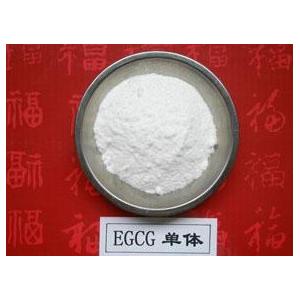
Add to Cart
Epigallocatechin Gallate /EGCG 95% ·
----Good quality & Excellent service
Product Details:
 Prodcut name: Muscle-building Epigallocatechin Gallate /EGCG 95% /green tea extract
Prodcut name: Muscle-building Epigallocatechin Gallate /EGCG 95% /green tea extract
Synonym:(2R,3R)-2-(3,4,5-Trihydroxyphenyl)-3,4-dihydro-1(2H)-benzopyran-3,5,7-triol3-(3,4,5-trihydroxybenzoate)
Molecular formulas : C22H18O11
Molecular weight : 458.38
Appearance: off-white color powder
CAS number: 989-51-5
Used Part: Leaf
Grade: Food & Pharmaceutical
Test Method: HPLC
![]()
 Epigallocatechin gallate (EGCG), also known as epigallocatechin-3-gallate, is the ester of epigallocatechin and gallic acid, and is a type of catechin.
Epigallocatechin gallate (EGCG), also known as epigallocatechin-3-gallate, is the ester of epigallocatechin and gallic acid, and is a type of catechin.
EGCG, the most abundant catechin in tea, is a polyphenol under basic research for its potential to affect human health and disease. EGCG is used in many dietary supplements.
It is found in high content in the dried leaves of white tea (4245 mg per 100 g), green tea (7380 mg per 100 g) and, in smaller quantities, black tea. During black tea production, the catechins are mostly converted to theaflavins and thearubigins. via polyphenol oxidases.
EGCG is a kind of component extracted from Chinese green tea. It is the primary active and water-soluble component of green tea, which has the highest content among the tea catechins. By virtue of its peculiar stereochemical structure, EGCG possesses much stronger anti-oxidant activities and plays an important role in preventing cancer and cardiovascular diseases. In addition, it is potent as the reversal agent of MDR (Multidrug Resistance). As such, it may improve the sensitivity of cancer cells to chemotherapy drugs and reduce toxicity on the heart.

![]()
| Analysis | Specification | Result | Test method |
| Assay (egcg) | 95.0% Min | 95.12% | HPLC |
| Appearance | Off white powder | Complies | Visual |
| Part Used | Leaf | Complies | Visual |
| Extract Solvent | Ethanol & Water | Complies | Visual |
| Particle size | 100% through 80 mesh | 80 mesh | 80 Mesh Screen |
| Bulk Density | 40.0~65.0 g/100m | 49.1g/100mL | Complies |
| Loss on drying | 5% Max | 2.55% | 5g / 105℃/5hrs |
| Ash Content | 5% Max | 2.13% | 2g / 600℃ /3hrs |
| Heavy metals | 10ppm Max | Complies | AAS |
| As | 1ppm Max | Complies | AAS |
| Microbiology | |||
| Total plate count | 1000cfu/g Max | Complies | AOAC |
| Yeast & Mold | 100cfu/g Max | Complies | AOAC |
| E. Coli | Negative | Negative | AOAC |
| Salmonella | Negative | Negative | AOAC |
![]()
EGCG is the major component of the polyphenolic fraction of green tea. It makes up about 10-50% of the total green tea catechins includeing epigallocatechin gallate (EGCG), epigallocatechin (EGC), epicatechin gallate(ECG), epicatechin(EC), gallocatechin gallate (GCG), catechin are major catechin of green tea catechin. The antioxidant activity increased in the following order: EC<ECG<EGC<EGCG.
Many studies indicate EGCG plays a role, which protects aganist free-radical DNA damage, protects aganist the effects of ionizing radiation and ultraviolet radiation, inhibits lipid peroxidation, decreases serum cholesterol levels, LDL, VLDL and triglycerides, interferes with the binding of cancer-causing agents to cellular DNA, helps to neutralize dietary carcinogens, works with enzymes and other antioxidants in the intestine, liver and lungs to prevent the activation of certain carcinogens before they damage DNA. As a free radicals scavenger, EGCG combats the effects of pollution, sunlight and smoking, helps skin from wrinkling and aging.
![]()

![]()
Medicine, Health food, Food, Beverage, Cosmetics and Beverage, etc.